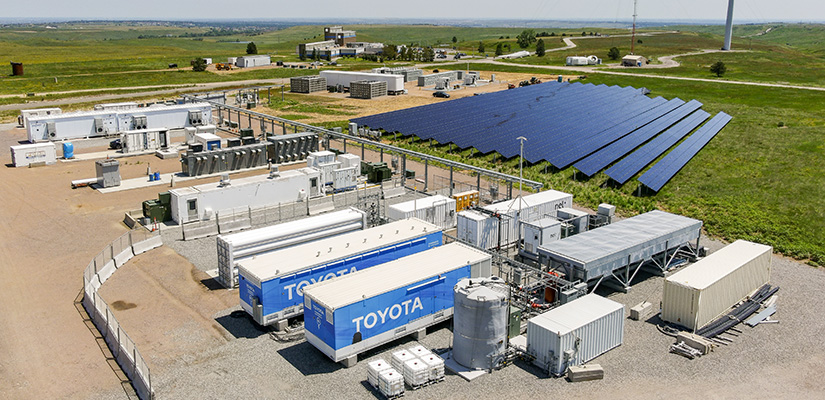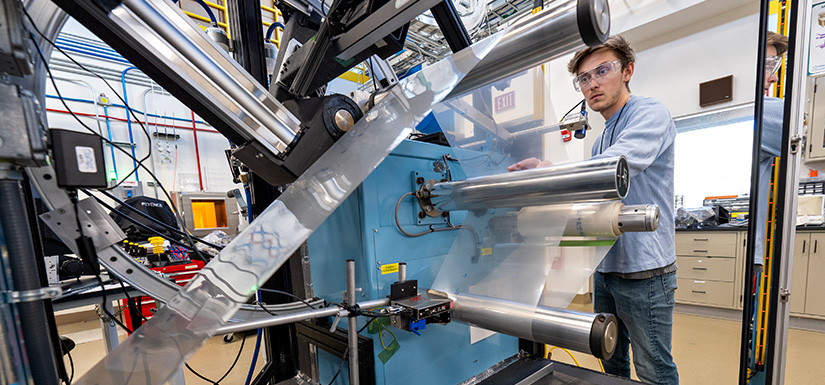
For National Hydrogen and Fuel Cell Day, NREL Spotlights Innovations To Make, Move, Store, and Use Hydrogen
Published by Todd Bush on October 9, 2024
NREL’s Hydrogen and Fuel Cell Research Is Unlocking the Energy Potential of Hydrogen
October 8 (10.08) is national hydrogen and fuel cell day—a nod to the atomic weight of the most abundant element in the universe: 1.008. This year, the National Renewable Energy Laboratory (NREL) marks the occasion by spotlighting its hydrogen and fuel cell research, which is lowering the cost and increasing the scale of technologies to make, store, move, and use hydrogen across multiple energy sectors.

Researchers work on an electrolyzer stack that splits water into hydrogen and oxygen using renewable electricity. Photo by Werner Slocum, NREL
Hydrogen is a simple and versatile energy carrier that can provide clean energy for the most difficult-to-decarbonize sectors. Together, those attributes make hydrogen a key part of the U.S. Department of Energy’s (DOE’s) efforts to enable a clean and low-carbon economy. Through its Hydrogen Shot, DOE aims to reduce the cost of clean hydrogen to $1 per kilogram by 2031.
NREL research and development (R&D) supports DOE goals and enables industry to take advantage of the broad potential of hydrogen—whether used as fuel for heavy-duty vehicles, a feedstock for sustainable chemical and steel production, or a medium for storing energy.
R&D Highlights
Megawatt-Scale Hydrogen Systems Research Kicks Off at NREL's Flatirons Campus
NREL highlighted the status and initial performance of the grid-integrated megawatt-scale hydrogen electrolysis, compression, storage, and fuel cell generator system at NREL's Flatirons Campus in a webinar. The presentation included details about ongoing research using NREL’s Advanced Research on Integrated Energy Systems capabilities, as well as future areas of research asset development.

NREL's integrated megawatt-scale hydrogen technologies system allows partners and researchers to create, store, and use hydrogen in a full grid environment. Photo by Josh Bauer/Bryan Bechtold, NREL
>> In Other News: Carbon Capture and Storage (CCS) Needs a Major Boost to Reach 2°C Climate Target
Offshore Wind Turbines Offer Path for Clean Hydrogen Production
Producing hydrogen at a cost that approaches the DOE goal for low-cost clean hydrogen depends significantly on both the technology used and production location. Using electricity generated by offshore wind turbines as one pathway to split water to produce clean hydrogen may make economic sense, particularly along the U.S. Atlantic Coast and in the Gulf of Mexico, according to researchers at NREL.
NREL Selected as Part of $1.6M in Federal Funding To Explore Potential of Geologic Hydrogen
Geologic hydrogen is currently a poorly understood but potentially groundbreaking energy resource involving certain types of rocks and subsurface environments that produce natural hydrogen. NREL was recently selected as one of 16 teams to research enhanced production of geologic hydrogen. Together with partners, NREL will help stimulate hydrogen production from iron-rich mafic and ultramafic rocks via chemical, mechanical, and biological processes.

NREL’s roll-to-roll web line is used for research of in-line quality control monitoring techniques for battery, electrolyzer, and fuel cell materials. Photo by Werner Slocum, NREL
New NREL-Led Lab Consortium To Enable High-Volume Manufacturing of Electrolyzers and Fuel Cells
Launched in 2024, the Roll-to-Roll (R2R) Consortium aims to advance efficient, high-throughput, and high-quality manufacturing methods and processes to accelerate domestic manufacturing and reduce the cost of durable, high-performance proton exchange membrane fuel cell and electrolyzer systems. R2R joins an expanding group of national laboratory consortia with a strategic focus on facilitating low-cost, clean hydrogen technologies.
NREL Advances Hydrogen Fuel Dispensing for Medium- and Heavy-Duty Vehicles
In another webinar, NREL highlighted research advances in fueling protocols, dispensing hardware, codes and standards, and station architecture for medium- and heavy-duty vehicles. Researchers performed fast-flow fueling tests at NREL, benchmarking system performance and exceeding industry and DOE targets. Several team members were also recognized by DOE for their outstanding contributions.

NREL's heavy-duty hydrogen fueling team. Photo by Agata Bogucka, NREL
NREL Model Fast-Tracks Hydrogen Supply Chain Infrastructure Deployment
Reducing capital and viability risks for infrastructure investment decisions will accelerate the adoption of hydrogen fuel cell electric vehicles. NREL is helping stakeholders forecast demand and minimize infrastructure buildout costs. NREL’s Scenario Evaluation and Regionalization Analysis model optimizes hydrogen infrastructure buildout to meet the growing needs of this emerging market.
Project Demonstrates Clean Supply Chain of the Future, Using Today's Technology
For 12 months, zero-emissions vehicles powered a clean demonstration supply chain—from battery-electric harbor cranes, which unloaded cargo containers from ships, to hydrogen-powered trucks, which drove goods from ports to storefronts across Southern California. The results from the Port of Los Angeles' Shore to Store project are in: a zero-tailpipe-emissions supply chain is possible, using today’s technologies.
Learn More
Read the DOE blog, Celebrate Hydrogen Day All Week Long, to learn about how you can get involved in this week’s celebration and discover fun facts about hydrogen!
Learn more about NREL's research in hydrogen and fuel cells.
Subscribe to the newsletter
Daily decarbonization data and news delivered to your inbox
Follow the money flow of climate, technology, and energy investments to uncover new opportunities and jobs.
Latest issues
-
G20's Carbon Removal Gap Opens $1 Trillion Door
Inside This Issue 💰 G20's Carbon Removal Gap Opens $1 Trillion Door ✈️ Gold Standard Labels First Credits As Eligible For CORSIA Compliance 🌲 Chestnut Carbon Has Sold High-Integrity IFM Carbon Rem...
-
How Direct Air Capture Could Drop 75% in Cost
Inside This Issue 💨 How Direct Air Capture Could Drop 75% in Cost ⚡ Cache Power Advances 30 GWh Compressed Air Energy Storage Project In Alberta 🪨 Canada Nickel And The University Of Texas At Aust...
-
EPA Rule Unlocks $20B Biofuels Boom: The Decarbonization Players Who Gain
Inside This Issue 🌾 EPA Rule Unlocks $20B Biofuels Boom: The Decarbonization Players Who Gain ⛏️ DMS Georgia: World’s First Deep Mine Carbon Storage 💧 Dirty Water Boosts Prospects for Clean Hydrog...
Company Announcements
-
Topsoe Technology Enables Green Ammonia Production in the U.S.
Synergen Green Energy has chosen Topsoe as the technology licensor for its green ammonia plants to be built in the U.S. Topsoe will deliver its dynamic ammonia loop technology and its proprietary ...
-
A data-driven blueprint for identifying and designing nature-based voluntary carbon market (VCM) projects that deliver both carbon and biodiversity outcomes. NEW YORK, NY (November 3, 2025) — Carb...
-
Flagship system marks Plug’s first commercial electrolyzer deployment in the Netherlands and serves as a path for future Dutch hydrogen hub developments SLINGERLANDS, N.Y., Nov. 05, 2025 (GLOBE NE...
-
Gold Standard Labels First Credits As Eligible For CORSIA Compliance
Date: Nov 5, 2025 Location: Geneva, Switzerland Released by: Gold Standard Download Media Release Today, Gold Standard has for the first time labelled carbon credits as eligible to be used under ...